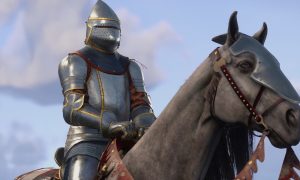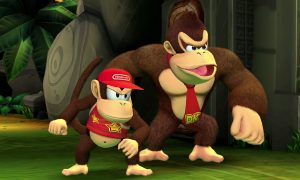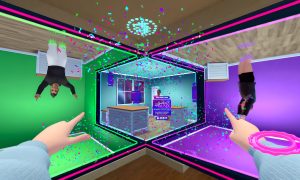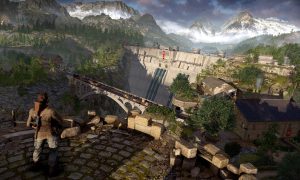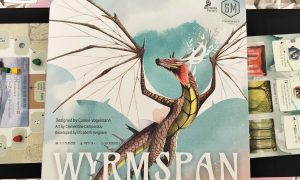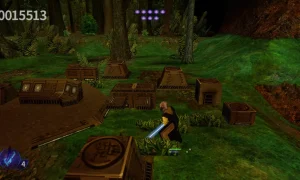Fists were flying Friday Night at Blizzard’s Behind the Scenes of Overwatch’s Newest Hero at San Diego Comic-Con. Every single person who attended the panel received a foam Doomfist, and took every available opportunity during the panel to cheer and raise their oversized appendages into the air, as well as a copy of the newest Overwatch comic, #13. The panel was moderated by Michael Chu, the senior designer for Overwatch, who was joined by Renaud Galand, lead character artist who modeled Doomfist in 3D, Arnold Tsang, assistant art director who created the concept art for Doomfist, and Geoff Goodman, the principal game designer for Overwatch. After some brief introductions, they decided to give us a reminder about what we were here to see, queuing up the Doomfist Origin Story video. Unfortunately, technical difficulties meant that there was no sound for the video, prompting the team to both narrate and provide their own sound effects, including a sound effect of “punch!”
Technical problems resolved, Doomfist himself made an appearance on stage, in the form of a cosplayer who prowled behind the speakers with a menacing gait, his impressively large and detailed gauntlet glowing. “Doomfist has escaped his containment unit and he’s out to terrorize the world; he’s made his first stop here in San Diego,” Geoff laughed. “I get the feeling I need to moderate this panel really well, or else,” Michael added. Shifting their focus to the large screens, the team walked the audience through the development process for Doomfist and other Overwatch heroes, sharing never before seen concept art and explaining changes as they went.
Doomfist’s early develpment, they explained, had roots in the very concepts of Overwatch, and the name came from simply trying to think up the coolest combination of a noun and an adjective. Doomfist is a character who evolved from a name, as the Doomfist was intended to be a relic, an item Widowmaker was intent on acquiring. “We were trying for it to be a very ,very valuable relic,” Geoff explained, “but we felt like ultimately it was a little too fantastical, it looked like it was powered by magic. We decided we wanted something a little more mechanical to make it fit in the Overwatch world.” The original concept art for the Doomfist, was displayed for the first time, alongside the final art.
The next step for any given Overwatch character, the team explained, is Hero Production. “We have three plus super early prototypes going on at any given time at Overwatch,” Geoff explained as the screen filled with early concept art for Doomfist. Originally, the team planned to make Doomfist a tank, as his rather massive size lended itself towards having lots of hit points and the capability to absorb a lot of damage. He could jump in and grab people and hold them like a human shield, he could throw people off a cliff or into other heroes. Early on, the team struggled with kit as they tried to shape him as a tank while still keeping the focus on his punching. The result was that many of his iconic punching abilities were set aside in favor of moves inspired by grappling or wrestling. It may not have made it to his final incarnation, but it was apparently very fun to play, as Geoff explained: “One of our level developers was almost in tears every time he played him, because throwing heroes around was just so much fun.”
We saw clips of early Doomfist gameplay, where Doomfist manifested as a frankenstein combination with Reinhardt’s right fist and a rocket launcher standing in as his left hand. “That’s how every hero starts out for us, kind of hacked together from other characters,” Michael Chu added. We watched from a first-person perspective as Doomfist ripped rocks from the ground and hurled them at other heroes, grabbed characters by the throat and hauled them off the ground, and fired projectiles which automatically exploded after a certain distance. “We just kept getting away from punchy guy,” Geoff said, explaining why those movesets were moved from the game. “We didn’t want that, Doomfist is our homage to fighting games.”
From there, Doomfist moved on to the Blockout phase, an intense five to ten day, not very detailed 3D rendering where the artists go back and forth with the team and try to shape the character. The team spent some time expanding on the difficulties of building Doomfist’s kit. Geoff explained, “He’s all about combining all his moves together, so we couldn’t have a reload interrupting that. His very first interaction was just punching, but he couldn’t really punch anyone because he couldn’t stay close. Genji also faced problems with melee, with making it work in the game.” Geoff went on to explain a concept which never even made it to the art phase, where Doomfist would punch the air, triggering a phantom fist which would travel a distance to strike his enemies.
It was around this time that the final decision was made to move Doomfist out of the tank category. During their efforts to balance his character, they found they couldn’t make his punches too powerful, given his HP and damage absorbing nature, and that, Geoff explained, simply did not fit with the character. “You don’t get hit by the doom fist and not feel it.” We then got to see early video of Doomfist’s kit inside of Dylan’s playground, a testing ground used, Chu explained, exclusively to test new heroes, blow things up, and punch Tracer. “That’s the only point of this room.”
Moving on to the Scale Check, the crew explained that they wanted Doomfist to be huge and imposing so they made him almost as large as Reinhardt, only without armor. With scale confirmed, the character moves on to the Highpoly Phase, where the 3D team renders the character in astounding detail. “It’s literally millions of triangles that would never work on a computer,” Arnold explained. “They make a low-poly mesh, then detail the low poly one and polish up materials.” Weathering and other details are carefully added as Overwatch has its own specific weathering style which is part of the game’s style guide. Objects are weathered enough to give the impression of wear, but areas are deliberately left blank, “to give the mind room to breathe.”
The next step in the process is the Hero Abilities, and we were treated to a series of concept art illustrations alongside video of the final ability in game. Doomfist trails lightning as he moves, and while it is blue in the game, the lightning was always red in the concept art. The team explained that Doomfist was always intended to have red abilities, as red is such a powerful villain color. However, this had to be changed because of how confusing it became in game, since teammate abilities are always blue. “The opponent Doomfist, the red Doomfist, will always be the truest Doomfist to me,” Michael added.
The team took a lesson learned from their early work with Tracer and used a lightning trail to help players keep track of Doomfist’s location. They were also very careful with the sound of his charge-up punch, wanting to make sure that it sounded like nothing else in the game, and that it was loud enough that someone wouldn’t accidentally walk around a corner and into the Doomfist. Doomfist’s ultimate ability is actually a hand-me-down move, originally created for Orisa. They were working on the two characters at the same time, and while the move did not fit her kit, the developers really loved the move itself, so it was given to Doomfist, instead.
Our next look was into Doomfist’s skins, many of which are tributes to his Nigerian heritage. Michael Chu also took a moment to defend himself and address a point of Internet outrage. “Everyone wondered why I didn’t know what a cheetah was! In my defense, the original concept of the skin looked a lot more like a cheetah.” The team also took the time to discuss the detailing of the left nipple on his Irin skin, laughing as they explained how Geoff told an artist time and time again to take it out, and how said artist would smile, wink, and put the nipple back on the moment Geoff left the room. The nipple, it is worth noting, made it past the final cut and into the game.
The final look was at the story behind Doomfist’s character. “I always say that maps are more interesting when there’s a hero tie in, but heroes are more interesting, also. So we wanted to make a character that Orisa would eventually stand up to,” Geoff explained as we saw art of a young Efi Oladele, Orissa’s creator, standing before Doomfist’s containment unit. The team deliberately created an interesting dynamic between the two characters, with Doomfist having the ability to throw people around, and Orisa being able to say “nope” and completely negate that ability. Geoff ended the talk with a thought about Doomfist’s origin movie: “It’s always been a dream of me to see 2D animation for Overwatch.”
With the panel over, fans hurried forward in hopes of getting their comics and foam fists signed by the creative crew. While their hopes were granted, the general public did have to wait a bit, as the Blizzard team dedicated their time immediately after the panel to introduce themselves, and their Doomfist cosplayer, to a group of Make a Wish foundation children, ensuring they got all the photos and autographs their little hearts could desire.
Chaotic wholesome. Dice-maker. DM and TTRPG performer. Shiny Pokémon hunter. Kay works in video games during the day, speaks at conferences during the weekends, and pretends to be an orc, tiefling, android, etc by night.

See below for our list of partners and affiliates:













